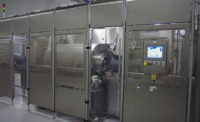When it comes to sustainability, a lot of attention is paid to the perimeter of a cold food processing facility, for example, thermal insulated walls, LED lighting, equipment controls and washdown flooring to name a few. But, not much attention is directed to the top of the plant—the roof.
Enter solar roofing—what is said to be the most energy efficient way of generating clean energy to power a plant.
“Roofs are a valuable resource and should be considered as an asset that shouldn’t be wasted on low-performance equipment,” says Martin Morehouse, ST engineer and estimator for Sun Light & Power, Berkeley, Calif. “Because of the energy intensity of refrigeration and processing, the biggest challenge of going solar is making a significant impact on the energy usage.”
That’s why Sun Light & Power introduced the SunPower Helix ballasted solar photovoltaic (PV) system, which pairs solar modules with dense installation tools to increase energy output of the available roof space.
“The energy density of the Helix system maximizes the use of space on roofs and provides the best possible outcome,” says Morehouse. “In California, AB32 is increasing the regulatory requirements on food processors. Intelligent companies are using solar as a way to increase their operations without increasing their carbon.”
Meanwhile, SolarWorld Americas Inc., Portland, Ore., partnered with Enphase Energy, Inc., Petaluma, Calif., to develop an integrated alternating-current solar panel that offers module-level optimization, enhances power output and meets NEC 2014 and 2017 690.12 rapid shutdown requirements.
For its part, RBI Solar, Cincinnati, unveiled its latest solar racking system. This next generation ground-mount solution is compliant with ETL Classification from Intertek to UL Standard 2703, and includes a wider selection of component parts such as economical upright post and top chord engineered to bear the load while using less steel. Additional features include multiple foundation designs that are compatible with a variety of site-specific soil and ground conditions, as well as structural components to match wind and snow loads.
HotWattEnergy, Harrison Township, Mich., addresses today’s solar roofing challenges by implementing a design that’s specific for the building and the business.
“Our design in capacity, weight, shading along with module, racking, inverter and wiring specifications allow us to engineer a tried-and-true system that operates at peak efficiency,” says Shawn Verbrugghe, director of operations.
To navigate the complexities and challenges in deploying renewable energy sources such as solar roofing, technology advisors such as Alta Energy, San Mateo, Calif., provide expert guidance in analysis, strategy formation and execution.
“We have helped Merrill Farms complete a ground-mounted solar project that will cut their utility bills by $12 million over the life of the project,” says Marc Roper, vice president of marketing. “Rooftop solar (and ground-mounted solar) offers many benefits to the cold food industry. First and foremost is a reduction in electricity costs. The cost of solar technology has fallen to the point where it is simply less expensive than conventional utility electricity in many markets, and the cold food industry can benefit greatly from this, especially in regions where electricity costs are high (e.g., California). Significant tax incentives are available, and these benefits can be passed along to the consumer through a variety of financial structures. In addition to lowering cost, shifting some portion of a facility’s electricity supply to solar can mitigate the uncertainty of overall energy costs due to utility rate fluctuations. Installing solar also qualifies for points toward LEED certification, and can be the difference in achieving higher levels of certification than otherwise possible without solar. Finally, solar can be a significant element of a carbon reduction strategy, as the use of solar electricity offsets the generation of electricity from conventional resources that emit greenhouse gases, such as coal or natural gas.”
Solar roofing will continue to grow in the cold food industry, especially as solar prices continue to drop and roofing manufacturers continue to develop new solutions, says Alex Crown, commercial sales representative for REC Solar Inc., San Luis Obispo, Calif.
“For example, if roof integrity is an issue, but nearby land is available, we might create an off-site solar farm to power the facility (or multiple facilities),” adds Crown. “Another example of new solutions is solar power storage. We are now building solar systems with battery storage on-site to release excess energy during peak-use periods, helping reduce demand charges. Software and data are also helping to better manage electricity usage throughout a building, so solar system performance can be better mapped to energy monitoring, maximizing how much we offset utility costs through solar power.”
Case Studies of Solar Roofing Projects
As solar prices continue to drop and the need to be more sustainable rise, more and more cold food processors are installing solar roofing solutions. For example, Whole Foods Market, Austin, Texas, worked with NRG Energy, Houston, Texas, and SolarCity, San Mateo, Calif., to increase the number of rooftop solar units on its U.S. stores. Whole Foods Market aims to install up to 100 additional solar rooftop units, making it what is dubbed as the 25 largest commercial rooftop solar installations in the country. The expanded solar portfolio could also increase Whole Foods Market’s solar energy portfolio by up to 400%, helping supply cleaner power to the grid.
Herbold Meckesheim USA turned to RGS Energy, Louisville, Colo., to install a rooftop solar energy system that provides electrical power to its 10,000-square-foot Smithfield, R.I., headquarters facility. The system, which consists of 80 panels, takes up about 20% of Herbold’s available roof space, and is capable of producing 28,000 KW of clean, reliable, renewable energy.
Del Monte Foods, Inc., Walnut Creek, Calif., tapped SunPower Corp., San Jose, Calif., to install solar rooftop arrays on both its Hanford and Kingsburg, Calif., plants. Today, this combined 1.9 megawatt solar rooftop installation is said to be the largest of its kind in California’s Central Valley.







